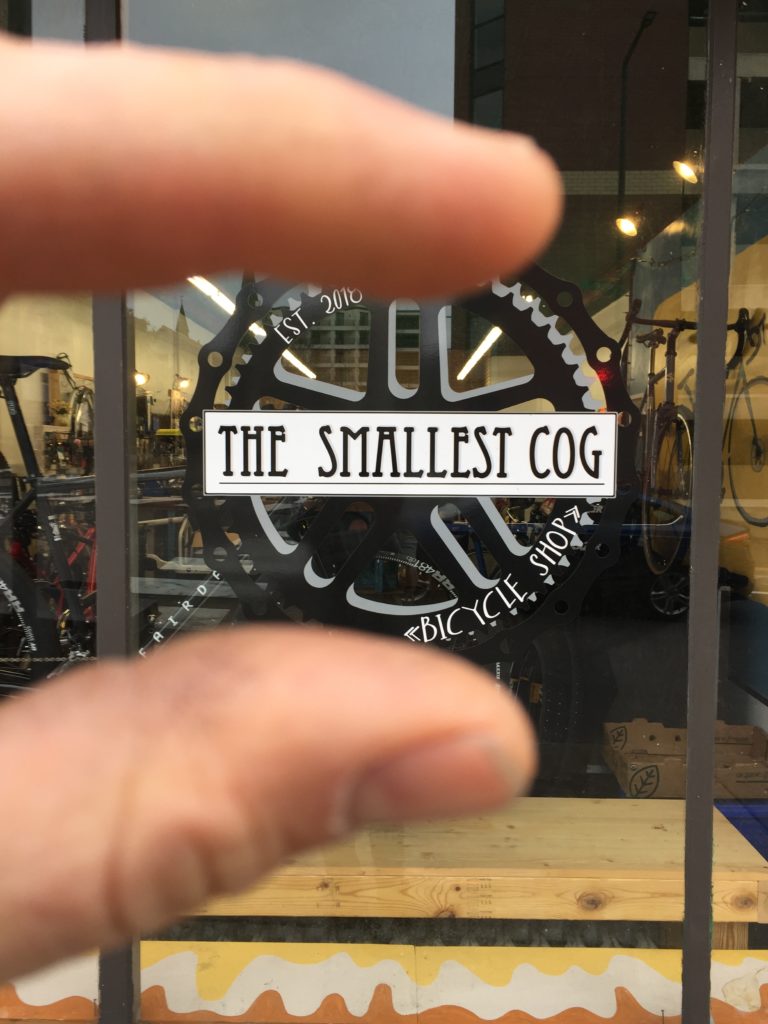
As we close out our second season in the business we have been reflecting on who we are, what our niche is, and what our vision is for the next 5-10 years. Other people are asking us these questions too. Eighteen months after we opened our doors our responses to those questions remains the same: We are an independent, self-financed, service-focused bike shop which has built a customer base through advocacy, word-of-mouth, and (of course) great service. Our niche is that we are small and we are good.
Since opening we have by design and out of necessity pursued a slow growth business model. That’s how it goes when building a business powered by personal savings, a side hustle, and an AmEx card obtained when I had a salaried job. Four or five months in the business was generating enough cashflow that it was able to purchase inventory, pay rent, and set aside money for rent in the colder months. In that first year of operation I paid myself $3,000.
This year has brought its own set of challenges. Our slow growth model doesn’t always interface well with the biking industry. Most days I wonder if we are the smallest cog in their machine. Our diminutive size means that we don’t enjoy volume discounts on tubes, tires, bikes, and everything else. We get it: It’s not just, it’s just business. But it is going to be a problem one day when the only bike shops still standing are Erik’s, Freewheel, and a handful of boutique shops. We don’t want to be Erik’s and we don’t want to be a boutique shop.
So is the neighborhood bike shop an anachronism or is it feasible? More to the point: Is any small scale retail viable in a space dominated by Amazon and large brick and mortar chains? Talk to us five years from now and maybe we’ll have your answer.
In the meantime we humbly suggest some changes to the retail environment which could allow new small businesses to bloom:
- Pass a living wage ordinance, like, yesterday. The smallest small business — ahem, us — are usually exempted, but our competition, because they are bigger, takes the hit. And they damn well should be paying their people more. This was a record year for the biking industry and those front line workers should share some of the spoils for taking all the risks.
- Tax the hell out of vacant storefronts. That storefront is vacant for a few possible reasons including: the rent is too high, the demand is low, or the retail space needs to lose money as a write-off because it is part of someone’s investment portfolio. That vacant storefront imposes a cost on adjacent businesses because it can attract undesirable uses which, in turn, makes the street unwelcoming. Just ask any of our neighbors if opening our shop improved the corner and the neighborhood. Just ask us how much we’d like a tenant in the empty storefront next to our shop (yes, please!). Taxing vacancies might provide incentive for some landlords to look harder for a tenant, to lower their leasing rates, and it might even provide the city a revenue stream for addressing quality-of-life issues in the downtown area.
- Take a holistic approach to retail corridors and business development. Successful businesses rarely exist in a vacuum; they are often part of a looked-after corridor, node or district. A great example of a nearly-complete corridor is Grand Avenue because it has a critical mass of businesses; it has street trees and trash cans; and it is an interesting place to walk. But could be a lot better if traffic were slowed so pedestrians could safely cross the street. And when traffic slows good things happen. No one window shops at 40 mph. No one wants to dine in a parklet with adjacent traffic moving that fast.
- Work to attract and retain small businesses. Saint Paul (and other midsize to large cities) prefers the supernova approach to the thousand points of light approach when it comes to economic development. This approach manifests as ball parks, sports arenas, large convention halls, and Class A office space intended to lure big corporate fish. It almost always involves a sales tax levy to pay for the stuff and to build lots of structured parking. A less expensive, harder, but more sustainable approach would be to fund a small business liaison office which could help new businesses find space, connect with lenders, obtain business services (regulatory compliance, insurance, accounting, internet, healthcare, etc) at a subsidized rate. Where would we get the money for that? See #2.
These are all feasible ideas and none of them are original. COVID (or not), unrest (or not), recession (or not), there are small businesses that need help. What we have learned in 2020 is that when disruption happens it isn’t the agile that survives — as we might have been led to believe by Charles Darwin or Malcolm Gladwell; it is the already advantaged businesses that are in the best position to hang on (read: large PPP loans/grants) and even grow (Amazon, Instacart, and big box retail). This has to be corrected because the worst thing for Lake Street would be to rebuild as a corridor of wine bars and cheese shops operating in buildings owned by real estate investors.
Our next blog post will be about real estate because that, probably more than any single factor, determines the success or failure of a business. The TL;DR is the rent is almost always too damn high.